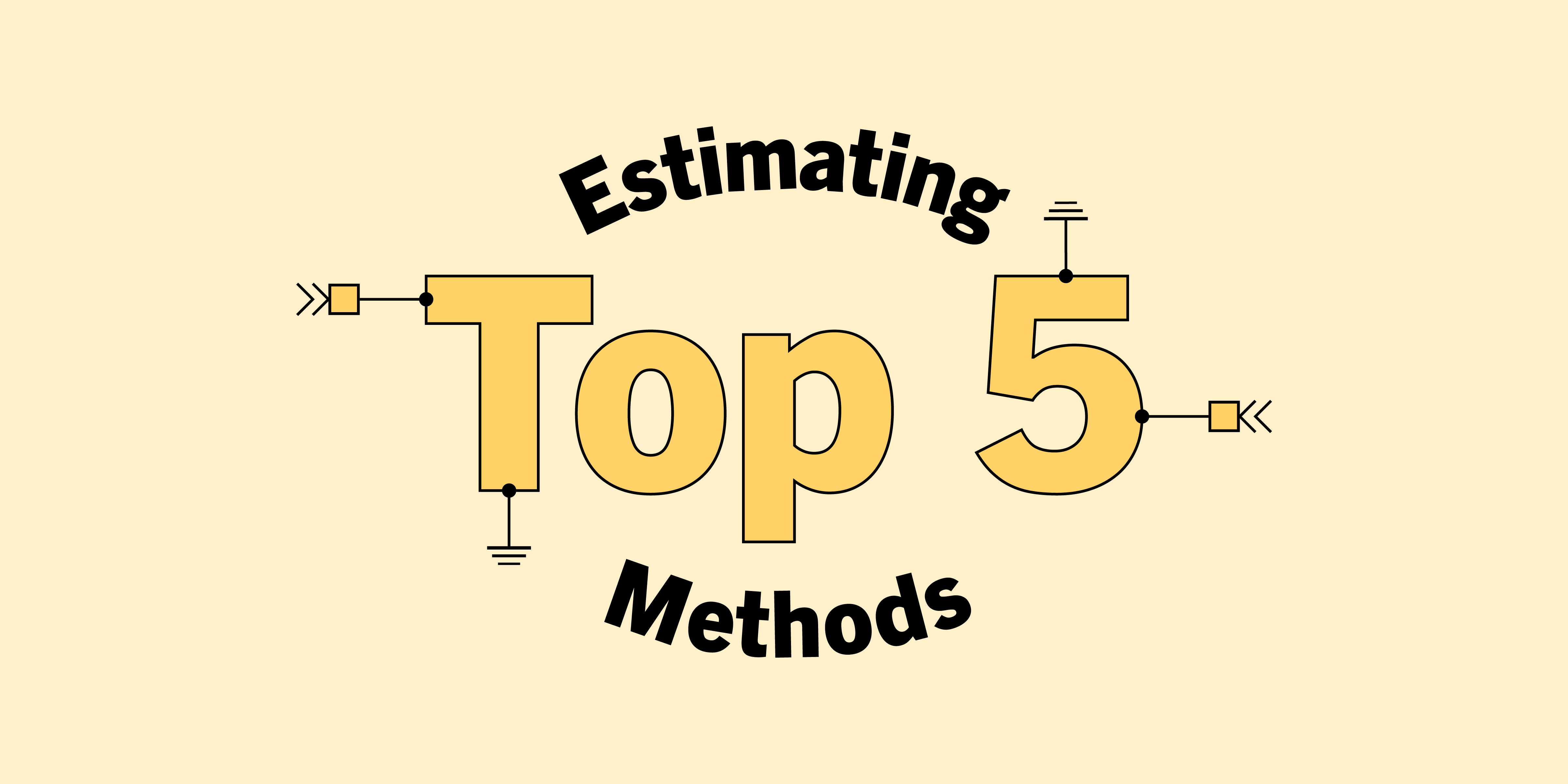


21 September 2020
Ask any electrician what they love about their job, and chances are it won’t be estimating. When you’re just starting out, it’s pretty daunting – how do electricians price up work, charge for their time and estimate enough… but not too much? And even if you’re a seasoned pro, how do you know you’ve found the quickest, easiest way to estimate – or the way most likely to win work?
Worry not, we’ve got you. In today’s blog we’re looking at the five most common electrical estimating methods, and weighing up their pros and cons. We’ll break them down, look at how electricians price up jobs in different ways, and help you hit on the one that works for you – so you can price up faster, better and with a lot less stress.
Estimates bring in work. They’re a massively important part of any electrician’s business, but we’re all guilty of putting them off, pushing them back and finding other jobs to do.
It’s easy to see why. When we don’t know what a customer’s expecting, what the competition’s quoting, or whether we’re working it out right, we’re not exactly filled with confidence… so we drag our dreaded paperwork out. Even worse, when we get estimates done and the customer goes elsewhere, it’s easy to feel like we’ve wasted our time.
So let’s fix this. Let’s pin down the best electrical estimating methods and give you an easy, effective formula that gets estimates out fast – and wins work – time and time again.
Show paperwork who’s boss and finish on time for once. Click To TweetOk. Everyone’s different, and what feels like common sense to one electrician might not to the next. That’s why we’re going to look at the pros and cons of five electrical estimating methods. We’ll break them down – you take your pick.
Let’s kick things off with the time + materials approach. It’s a practical, reliable electrical estimating method based on how long a job’s going to take, plus the cost of materials. As well as helping you work out ballpark estimates, it gives you enough detail for full electrician’s quotes too (not 100% clear on the difference? Check out our Quotes vs Estimates blog).
You’ll need a couple of things to get started with the time + materials approach. First, a clear idea of what your hourly rates are. Working out a realistic rate that covers your living and business costs gives you a solid starting point for more confident, consistent estimates and quotes. If you need a hand, read our blog on how to calculate your electrician’s labour rate.
Second, you’ll need a quick way of costing up electrical materials. These days most suppliers have websites and some even have apps that speed the process up (check out our quick guide to great apps for electricians for some tips). Don’t forget to mark up your materials to cover your time sourcing them and getting them to site.
This formula-based framework makes sure you cover your costs, get paid at a decent rate, charge the right amount for materials and don’t lose out. It’ll give you the confidence that there’s strong reasoning behind your prices, which you can break down in detail if need be, showing how honest, methodical and professional you are.
It can be nerve-racking to work out a labour rate, (although this blog will help) and even if you work out how many hours the job needs, there’s a chance it’ll run over. That’s a risk, whatever electrical estimating method you use, but at least if you’ve listed your expected hours, you stand a chance of convincing the customer the job was more complicated, and negotiating a little extra.
You like the idea of a strong formula that covers your costs.
You’re uncomfortable setting an hourly rate (you shouldn’t be!).
✏️ Pro tip:
Save regular materials prices in YourTradebase for faster estimates, every time.
Next in our run-through of electrical estimating methods… the guesstimate. Otherwise known as pulling a figure out of the air based on your experience and assumptions. Yes, it’s about as precise as it sounds, but remember an estimate’s a ballpark figure rather than a price you can be held to. When it comes to full-on quoting, it’s risky, so tread carefully.
It’s certainly quick… with a whole lot less working out. And if you’re very experienced, it might just be reasonably accurate (fingers crossed). We’re struggling for more plus points though.
Without a real basis for your figures, you’re more likely to undercharge or overcharge, which could leave you out of pocket, put potential customers off or even lead to disputes later on. And if your customer feels you’re guessing, it won’t make you look very professional, or generate much faith.
You’ve got tonnes of experience and you’re super clear it’s a ballpark figure.
You’re new to the game or your customer wants a definitive price that won’t change.

Onto our next electrical estimating method – and this one’s a little different. The working to a budget approach puts your customer in control. Just ask them what their budget is for the electrical work, then tell them what you can do for that price. It’s more suited to projects than quick hour-or-so jobs, but it’s worth thinking over.
When it goes well, this electrical estimating method can be a real people pleaser. Your customer feels they’re in the driving seat, being listened to and accommodated – and they’re comfortable with what they’re spending.
From your point of view, as long as the budget they give you is realistic, you’ll know the price you’ve got to hit to get your estimate accepted. Less guesswork for you (but more for them).
Finally, there’s always the chance your customer totally overestimates and gives you a nice big budget, so you you can put in a comfortable estimate with a guaranteed profit, and still make them happy by coming in for less. If there’s still a lot of budget left when you’re finished, you could even bring the final price down – a powerful way to win trust and loyalty.
Most customers have no idea how long electrical jobs take, or what expertise and materials they involve. You’re the expert, so it’s a risky move to put the pricing in their hands.
If you know they’re taking the same approach with competitors, it puts a lot of pressure on you to come in below what might already be a pretty low budget. And if you can’t possibly do the work for their budget, you’ll be on the back foot before you’ve even put in your price – not a great start.
You’re confident they’ve got a decent budget or happy to tell them if they’re way off.
You feel you might be squeezed on price or they seem like a tricky customer.

The price list approach (also called a schedule of rates) is used by thousands of sparkies as a really useful way to write estimates or quotes quickly. It involves using your experience, along with a good understanding of your hourly rate and materials costs, to build a ready-to-go list of prices for regular jobs like installing new power points, changing LEDs or putting up lights.
This electrical estimating method is super useful for jobs you do week in, week out. You know what they involve because they’re your bread and butter. In fact, you could practically do them in your sleep, so there’s no need to price from scratch every time. Whether they’re small jobs or bigger projects, if you know you can deliver for a certain amount, it’s a great short cut.
As well as speeding up your estimating and quoting, the price list approach encourages you to learn from experience and keep track of your prices, so you can get faster and more accurate at pricing up the more you do it. Plus, if you want to find out what the competition’s charging, it’s easier to ask someone what they paid for a specific task and benchmark yourself against it.
In YourTradebase, we actually help you build your price list with every estimate or quote you write. Our app saves your prices automatically, so you can pick and choose from them next time.
A job that might initially seem the same as a previous one could prove more complicated, so only use your price list when you’re confident you know the score. For extra protection, include plenty of detail in your estimate or quote, so if the actual job demands something different, you’ll at least have a basis for negotiating more money.
You do the same tasks regularly and want to get faster at pricing up, every time.
You rarely do the same job twice.

This one isn’t so much an electrical estimating method as a state of mind. The it takes as long as it takes approach is a way of working with long-term customers that depends on (and fosters) trust and loyalty. Do what’s needed, keep tabs on your costs and tell them the price at the end.
If you’ve got a strong, established relationship with a customer and they’re happy to work this way, great. It means if you’re honest with them and get the job done in a reasonable time, you’ll never be out of pocket for the work you’ve done – every hour gets paid for. You’re building a partnership based on trust, mutual respect and clear communication.
Fallouts happen, and this approach does leave you open to disagreements over price, which could leave you with less money than you deserve – and little legal backup. Don’t rush into this kind of agreement until you’ve done a handful of properly estimated jobs for the customer.
You’ve been working together for years, you trust each other and you talk regularly.
You don’t know the customer well or you have any doubts at all – trust your gut.
✏️ Pro tip:
Track all your customer messages automatically in YourTradebase.
There are pros and cons to every electrical estimating method, so it all comes down to the kind of jobs you do, the kind of customers you’ve got and what you feel most comfortable with.
While the working to a budget approach creates certainty for the customer and the takes as long as it takes route can help to cover every hour you work, the time + materials and price list based approaches are the safest, most professional options in our experience.
They give you a great formula for speeding up the quoting and estimating process, building your confidence and creating shortcuts you can use again and again.
They also interlink – the price list approach has its roots in a great understanding of time + materials. So once you’ve worked out how much time and materials you need for a regular task, it can become an item on your price list, without you having to do those calculations every time.
Building a price list in YourTradebase is really, really easy. In fact, we do it automatically. Every time you write a quote or estimate, we save each task to your price list so you can pick and choose from it the next time, and the next. So without any extra work, you get a super useful shortcut that speeds up the whole process, based on the prices you personally want to charge.
With quick estimate templates, a library of trade logos, easy ways to save your details and ready-written customer messages, YourTradebase also makes writing up and sending your prices really fast and polished too. You can even answer customer questions and get instant approval online – going from first enquiry to shiny green light faster (and more painlessly) than ever.
No fuss. No strings. No credit card needed.